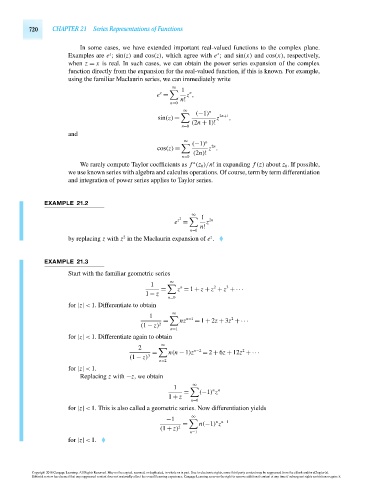Page 740 - Advanced_Engineering_Mathematics o'neil
P. 740
720 CHAPTER 21 Series Representations of Functions
In some cases, we have extended important real-valued functions to the complex plane.
x
z
Examples are e ;sin(z) and cos(z), which agree with e ; and sin(x) and cos(x), respectively,
when z = x is real. In such cases, we can obtain the power series expansion of the complex
function directly from the expansion for the real-valued function, if this is known. For example,
using the familiar Maclaurin series, we can immediately write
∞
1
z n
e = z ,
n!
n=0
∞ n
(−1)
sin(z) = z 2n+1 ,
(2n + 1)!
n=0
and
∞ n
(−1)
2n
cos(z) = z .
(2n)!
n=0
n
We rarely compute Taylor coefficients as f (z 0 )/n! in expanding f (z) about z 0 . If possible,
we use known series with algebra and calculus operations. Of course, term by term differentiation
and integration of power series applies to Taylor series.
EXAMPLE 21.2
∞ 1
z 2 2n
e = z
n!
n=0
by replacing z with z in the Maclaurin expansion of e .
z
2
EXAMPLE 21.3
Start with the familiar geometric series
∞
1
3
n
2
= z = 1 + z + z + z + ···
1 − z
n=0
for |z| < 1. Differentiate to obtain
∞
1
2
= nz n=1 = 1 + 2z + 3z + ···
(1 − z) 2
n=1
for |z| < 1. Differentiate again to obtain
∞
2
2
= n(n − 1)z n−2 = 2 + 6z + 12z + ···
(1 − z) 3
n=2
for |z| < 1.
Replacing z with −z, we obtain
∞
1 n n
= (−1) z
1 + z
n=0
for |z| < 1. This is also called a geometric series. Now differentiation yields
∞
−1 n n−1
= n(−1) z
(1 + z) 2
n=1
for |z| < 1.
Copyright 2010 Cengage Learning. All Rights Reserved. May not be copied, scanned, or duplicated, in whole or in part. Due to electronic rights, some third party content may be suppressed from the eBook and/or eChapter(s).
Editorial review has deemed that any suppressed content does not materially affect the overall learning experience. Cengage Learning reserves the right to remove additional content at any time if subsequent rights restrictions require it.
October 14, 2010 15:35 THM/NEIL Page-720 27410_21_ch21_p715-728

